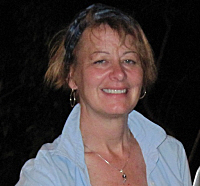
Speaking Friday at Maho Bay Camps Pavilion Restaurant, Gray has the science to back up what most residents can see with their eyes. She said the island’s coral reef ecosystem is damaged by land-based pollution and sedimentation, the result of St. John’s recent extensive development.
“But it’s not that hard to solve on a local level. You need the political will, which you have,” Gray said to the 50 or so people at Maho.
Gray cited earlier research showing St. John’s numerous dirt roads cause five to nine times greater sedimentation than controls.
“And the number of dirt roads increased dramatically in the last 30 years,” Gray said.
But other factors such as global warming, ocean acidification, over-fishing, hurricanes, diseases and coral bleaching are harder to tackle locally, Gray said.
This is the fourth year Gray and her team of students worked on St. John. She has monitoring sites at Great Lameshur Bay, Fish Bay and Coral Bay. The Lameshur site sits in an undeveloped area within V.I. National Park and essentially serves as a control.
Her studies show that the Lameshur area has little sedimentation. Fish Bay has lots of sediment on the reefs, but Coral Bay’s sediment problem is along the shoreline. In studying the Coral Bay area, Gray’s team discovered that the sedimentation at Calabash Boom, the site of the recently built Calabash Boom affordable housing project, is less than at the Shipwreck site in an adjacent bay. Gray attributed this to the installation of sediment ponds at Calabash Boom.
“Shipwreck is not mitigated,” she said.
The shoreline near the town of Coral Bay shows surprisingly less sediment, but Gray said this was probably due to the mangroves serving as filters.
Her studies include evaluating sediment suspended in the water, accumulated in sediment traps and on the sea floor, Gray said. Her team processes the samples at the V.I. Environmental Resource Station lab, located at Lameshur Bay, before sending the samples off to their labs at the University of San Diego for more in-depth analysis.
The Coral Bay Community Council has ongoing projects to mitigate the impact of development on Coral Bay. President Sharon Coldren said the organization received $1 million in federal economic stimulus funds and $300,000 from the U.S. Environmental Protection Agency to address the problem.
“But it will take $13 million to $15 million to take care of our bay,” she said.





